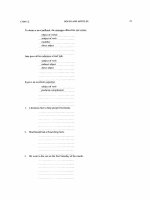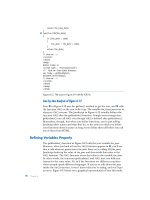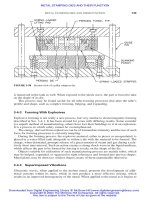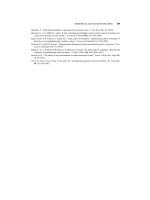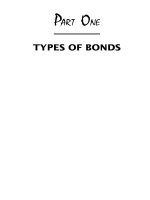Getting started in bonds 2nd edition phần 3 ppt
Bạn đang xem bản rút gọn của tài liệu. Xem và tải ngay bản đầy đủ của tài liệu tại đây (316.06 KB, 31 trang )
Moral of the story: Do the math; it will make you
money.
But if you’re still stymied and realize how important
it is, many online investment sites provide TEY calcula-
tors.
GENERAL OBLIGATIONS (GOs)
General obligation (GO—not pronounced go; it’s gee-oh)
municipal bonds are backed by the taxing authority of the
issuer. In other words, the local government is pledging to
pay back your principal and interest with money it re-
ceives either from taxpayers or from future bond issues.
No specific project is pegged to raise funds to pay GO in-
vestors. For example, the issuer has not said investors will
be paid back with money earned from the state’s water
project. The issues are paid off with money from the gen-
eral coffers of the government.
GO ratings reflect how fiscally responsible the issu-
ing governmental agency is. As with any bond, the better
MUNICIPAL BONDS
46
When you are comparing a municipal with a U.S.
Treasury alternative, you need to calculate the TEY
for the Treasury also, since Treasuries are exempt
from state taxation. To do so, subtract your state’s
tax rate from the number 1. Then divide this into
the Treasury yield-to-maturity (YTM).
U.S. Treasury’s TEY = YTM ÷ (1 – State tax rate)
To summarize, U.S. Treasuries are free from state
taxation. Municipals are free from federal taxation
and in most states free from state taxation (their
own issues). So you need to calculate the appropri-
ate TEY for each in order to equitably compare
them. Corporate bonds are fully taxable, so there is
no need to calculate a TEY.
backed
the interest
payments are
pledged to be
paid by (e.g., the
bond could be
backed by a
bank, equipment,
escrow account,
etc.).
the government’s credit standing the better its rating is
and the lower the interest rate it can borrow at. If it is less
of a risk, it can offer lower rates and still attract investors.
For example, Weston, Massachusetts, a wealthy
Boston suburb, is AAA-rated and rarely issues bonds be-
cause it doesn’t need the money. If Weston had issued a 10-
year bond in the summer of 2002 it would have had about
3.80% yield-to-maturity (YTM). At the same time an Aa/AA
muni would have yielded approximately 3.90% YTM.
Some investors prefer GOs over other types of munis
because they feel a government is less likely to go out of
business than a project such as a tunnel. However, wary
investors do not allow themselves to be lulled into com-
placency by such assumptions. Incidents such as Bridge-
port, Connecticut, threatening to go bankrupt in 1993
and Orange County, California, declaring Chapter 11 in
1994 shook the muni market to attention.
This doesn’t mean GOs are bad investments; in fact,
they are very safe. Just pay attention to the bond’s rating,
read research reports, and consult with investment profes-
sionals. And unlike most things in life, the most impor-
tant element here is the easiest. Just use your common
sense. (Remind me to mention this again in the investing
section, because this goes for any kind of investment.)
REVENUE BONDS
This is the other class of municipal bonds. Revs, as these
munis are affectionately referred to, are backed by the rev-
enues generated by a specific project’s user fees. The pro-
ceeds from the bond sale are used to build or maintain the
project.
For example, the revenue bond description:
Denver Colorado City & County Airport Rev.,
Baa1/BBB+, 7
3
/
4
% 11/15/2013
The issue is “secured by a pledge of the Net Revenues of
the Airport System,” meaning the issue will be paid off
with money made by the airport. Other revenue bonds
Revenue Bonds
47
yield-to-
maturity (YTM)
the yield you
would receive if
you reinvested
the coupon you
earn at a rate
equal to the
yield-to-maturity.
It is a more
accurate yield
than current
yield because it
includes the
positive effect a
larger coupon
has on your
investment
return.
are backed by fees from toll roads, bridges, tunnels,
civic/convention centers, and airports’ landing fees.
The bond’s rating reflects the financial prospects for
the project: how much it will be used, how much con-
sumers can be charged, whether constructing the project
is likely to stay within budget, how much it will cost to
maintain, and so on. Ratings can change when the
prospects for the project improve or erode. For example,
the Denver Airports mentioned in the preceding para-
graph were rerated in 2000 from Baa1/BBB+ to A/A+.
Revenue bonds are commonly felt to have a little
more risk than GO bonds since it is believed that there
is more that could go wrong on a project and that you
can’t raise user fees as much as you can raise taxes.
Whether this assumption is valid or not, it is the reason
a revenue bond often yields a little more than a GO with
a similar rating.
Another explanation for this difference is that rev-
enues also have the risk of catastrophe, albeit slight to
improbable: A tornado destroys the airport, exhaust
fumes ignite and blow up the tunnel, fire levels the civic
center While the media would lead you to believe
this stuff happens a lot, it is actually a rare occurrence.
We’ll also be talking about how municipal bond insur-
ance helps to mitigate what risk does exist.
GOs and revs are the two main muni issuers. They
issue a number of different types of munis that include
anticipation notes, alternative minimum tax (AMT)
bonds, insured bonds, callable and prerefunded bonds.
Let’s look at each of these in turn. Then we’ll look at
whether buying munis makes sense for you, and, if so,
how to decide which ones to buy.
ANTICIPATION NOTES:
TANs, RANs, & BANs
Since we’re muni bonds,
We have lots of fans.
But our time is short;
We’re TANs, RANs, and BANs.
MUNICIPAL BONDS
48
Chapter 11
when an entity is
unable to pay its
debts and has
declared
protection under
the bankruptcy
laws. This 1978
law keeps the
company in
possession of
and in control of
its business. It
allows the
creditor(s) and
debtor a lot of
freedom to
reorganize the
business and
hopefully be able
to pay off the
debts and
become a viable
business again.
This little poem introduces three members of the
short-term municipal family. It’s as if the municipality is
sitting in the middle of a desert, and there’s rain on the
horizon. Anticipation notes are the sprinkler that will sus-
tain it until the rain gets there. Just as cash management
bills and four-week T-bills are used in the Treasury mar-
ket, anticipation notes are issued when municipalities
need some stopgap cash to cover expenses until future
revenue is received; but, unlike cash management bills,
they are affordable for regular investors.
In the muni market, the securities called anticipa-
tion notes usually mature in less than a year. Like cash
management bills and U.S. Treasury bills, their short ma-
turity necessitates that they be discount securities. This
means they are sold at a discount to their maturing face
value, which includes both principal and interest.
One such security is the TAN; this stands for tax an-
ticipation note. The government expects to receive tax
revenue, but before the taxpayers mail in their checks, the
government has bills to pay, so it issues TANs to raise cash
to cover these interim expenses. When the expected tax
receipts are received, the money will be used to retire this
short-term issue when it matures.
There are a number of different anticipation notes:
BAN Bond anticipation note
RAN Revenue anticipation note
TAN Tax anticipation note
TRAN Tax and revenue anticipation note
GAN Grant anticipation note
SAAN State aid anticipation note
As you can see from the names, what distinguishes
these issues is where the government is anticipating the
money is going to come from to pay off these securities at
maturity. BANs will be paid off with the money raised by a
future bond issue. RANs are paid off from money earned
from projects such as toll roads, civic centers, and air-
ports. TANs bridge the gap until the government receives
Anticipation Notes: TANs, RANs, & BANs
49
our tax checks and cashes them. TRANs are paid with a
combination of revenue and tax funds received. GANs are
paid with money from a federal grant that the municipal-
ity will be receiving. SAANs are paid with state aid the
municipality is expecting to get in the future.
Some anticipation notes have an additional entity
backing the issue’s payments. They are letters of credit
(LOC), which say that the named entity—usually a bank
or large investment firm—will make the issue’s payments
should the issuer become unable to. LOCs can be used to
enhance any bond’s creditworthiness; however, in the cur-
rent environment, insurance has become so inexpensive
that insurance is usually used instead. We’ll talk about in-
sured bonds in a bit.
AMT BONDS
AMT stands for alternative minimum tax. This lovely, im-
mensely confusing concept assaulted our consciousness
with the Tax Reform Act of 1986, when it was aggressively
revamped from its 1978 origins. The alternative minimum
tax was instituted so that regardless of their accountants’
zealous efforts wealthy individuals and corporations
would have to pay at least some tax. However, this is a tax
that has outgrown its intentions since it was not indexed
to inflation. In 1990, 132,000 taxpayers were subject to
AMT. In 2000, the number had risen to 1.3 million. It is
estimated that by 2010, 17 million taxpayers could be
subject to the AMT tax.
1
Don’t panic yet; in 2000 only 1% of the population
qualified for this still pretty elite form of taxation.
2
Ac-
countants and the tax software programs available at of-
MUNICIPAL BONDS
50
1
The Alternative Minimum Tax for Individuals: A Growing Burden, Jim
Saxton, Chairman, Joint Economic Committee, United States Congress,
May 2001. On www.house.gov.
2
Alternative Minimum Tax: Overview of Its Rationale and Impact on Indi-
vidual Taxpayers, James R. White, United States General Accounting
Office, testimony before the Committee of Finance, United States Sen-
ate, March 8, 2001. On www.gao.gov.
letter of
credit (LOC)
a bank or large
investment firm
stands ready to
make the issue’s
payments should
the issuer
become unable to
make them itself.
fice supply stores can tell you whether you are subject to
this insidious tax.
So, why are we talking about ancillary taxes (ugh) in
a book about bonds? Well, because there is such a thing as
AMT municipal bonds, and because for 99% of us, these
bonds offer an opportunity for higher tax-exempt yields—
a very tasty investment choice!
AMT bonds are issued by entities that barely qualify
for tax-exempt status. They are private-purpose bonds
that are interpreted as serving the public interest, such as
hospitals or higher education institutions. Investors sub-
ject to AMT do not qualify for AMT bonds’ municipal tax
exemption and have to pay tax on their interest. There-
fore, they avoid AMT bonds and buy other types of mu-
nicipals or higher-yielding taxable bonds instead.
Furthermore, people subject to AMT tend to be ex-
cruciatingly wealthy and usually buy huge amounts of
municipal bonds, so their disinterest in AMT bonds dra-
matically lowers demand for AMT bonds and drives their
yields higher. Historically, AMT bonds have yielded about
20–25 basis points more than straight municipal bonds
(basis points are explained on page 148).
AMT yields also get an extra bump because a lot of
people who could benefit from buying them stay away
just because they don’t understand what AMT is. So if we
aren’t subject to AMT, we now know to check to see
whether AMT bond yields are higher than yields of other
munis; and we’ll be all over AMT bonds as long as the is-
sue is sound, it meets our other parameters, and we aren’t
in danger of becoming subject to the tax. Hopefully, Con-
gress will get its collective act together in regards to this
issue so that the nonsuper rich don’t become subject to
AMT. Well, at least they are talking about it.
CALLABLE AND PREREFUNDED BONDS
Municipal bonds come in both the callable and non-
callable varieties. This is a description of a callable
bond:
Callable and Prerefunded Bonds
51
alternative
minimum tax
(AMT)
this tax applies
to 1% of the
population. Its
intent is for the
wealthy to pay
taxes on private-
purpose
municipals. AMT
adds together
passive losses
(such as those
from tax shelters
and deductions
for charitable
contributions)
and income from
private-purpose
tax-exempt
bonds, then
subtracts a
certain amount
and taxes a
percentage of
this income that
is above a
minimum level.
Mass Port 5
1
/
4
% 7/1/18 call 7/1/08 @ 101, 09 @ 100
This means these are bonds issued by the Massachu-
setts Port Authority to mature in July 2018. However, they
may be called (i.e., retired) by the issuer in July 2008 and
after at a price of 101 and in July 2009 and after at a price
of 100.
Both GOs and revs can be callable. A bond’s calla-
bility can affect how it is priced and thus the yield it of-
fers. So, pay attention. You should be paid more yield
on a callable bond than on a similar noncallable bond
because issuers tend to call bonds when interest rates
fall. Just as homeowners refinance their mortgages
when interest rates fall, bond issuers want to refinance
when interest rates drop so they can pay a lower interest
rate on their debt. From the investor’s point of view this
is a negative because you now have to reinvest your
returned principal at lower rates. So, when issuers bring
a callable bond to market they have to pay investors
more interest due to the greater potential for reinvest-
ment risk.
Only callable bonds can be prerefunded. A prere-
funded bond is known as a pre-re (pronounced with a
long “e” at the end). If a bond you own is prerefunded,
you, in effect, now own a tax-exempt U.S. government
bond. The municipal issuer is no longer making the
bond’s interest and principal payment; instead, a U.S.
Treasury bond makes the payments. Many people like to
own prerefunded bonds for this added safety.
If the muni bond was rated below AAA before it
was prerefunded, its price should appreciate to a level
roughly equivalent to AAA muni bonds (sometimes
even a little higher since it’s basically a tax-exempt U.S.
Treasury).
Prerefunding is a way for issuers to lower their in-
terest costs when rates have fallen. They can get the
higher cost debt off their books before the bond’s call
date by prerefunding the issue. The issuer issues a
bond, known as a refunding bond, which has a lower
coupon than the old bond. The money raised in the new
MUNICIPAL BONDS
52
prerefunded
bond (pre-re)
outstanding
higher-coupon
bond whose
interest is no
longer paid by
the issuer but is
paid by a
Treasury security.
refunding
bond
new bond issued
to raise money to
prerefund an
outstanding
higher-coupon
municipal bond.
offering is used to buy a U.S. Treasury slug (SLGS—
State & Local Government Series) which pays the inter-
est on the outstanding muni until its first call date. On
the bond’s call date, money from the U.S. Treasury secu-
rity retires the bond.
When issuers want to refund noncallable bonds,
they are simply escrowed to maturity. As with pre-re’s,
there is a refunding bond that buys a U.S. Treasury slug
(SLGS), which pays the muni’s interest and principal in-
stead of the issuer. This doesn’t save the issuer interest
since the bond isn’t retired early; it just means it no longer
has to keep a reserve fund, so that cash is freed up to be
used for other things.
INSURED BONDS
Some investors like the added peace of mind that comes
with buying insured municipal bonds. They are willing to
forgo some yield to have an insurance company guarantee
that the bond’s interest or principal payments will con-
tinue even if the issuer becomes insolvent and cannot pay.
As with any type of insurance, you should know the
financial health of the insurance company that is insuring
the bond you are buying. You can study the company’s an-
nual report. In addition, many insurance companies have
been evaluated by the rating agencies. The most well
known and accepted insurance companies enjoy an AAA
rating. These private companies insure most of the bonds
in the insured municipal market. These industry leaders
include:
MBIA Municipal Bond Insurance Association
FGIC Financial Guaranty Insurance Company
AMBAC AMBAC Indemnity Corporation
(formerly American Municipal Bond
Assurance Corporation)
FSA Financial Security Assurance Holdings
Ltd.
Insured Bonds
53
slug
U.S. Treasury
bond that is
created to
exactly match
the cash flows of
a pre-refunded
municipal bond
(from SLGS—
State & Local
Government
Series).
escrowed
to maturity
money has been
put aside and
held in a
separate account
to pay all of the
bond’s future
interest and
principal
payments. The
payments are
assured and do
not come from
the issuer any
longer.
Bonds can be insured a number of different ways.
The bond can be issued as an insured bond, or insurance
can be bought after the bond is in the secondary market.
Insurance is available only for extremely large bond quan-
tities. So, unless your last name is Gates or Vanderbilt,
you probably won’t own enough bonds to insure them
yourself.
The cost of security insurance fell dramatically in
the 1990s. For example, a bond that cost $20 to insure in
the 1980s could be insured for about $2 a decade later.
Since insurance became so cheap—largely due to strong
economic times and competition among the insurers—
roughly half of municipal bonds issued in the 1990s were
insured.
CABs
There are also municipal zero coupon bonds available.
They are usually known as capital appreciation bonds
(CABs). The difference between the original discounted
price and the maturing face value is considered tax-free
interest. Note: You are also getting the internally rein-
vested income compounded tax free, which has a huge
impact on your total return.
TO BUY OR NOT TO BUY
Whether you’re buying munis in the primary or the sec-
ondary market, an excellent resource is the Bond Buyer. It
is a daily newspaper detailing new issues, credit updates,
and municipal market trends. It’s pretty pricey, so you
may not opt for a subscription; but it’s available at many
large libraries and online. Don’t buy munis from someone
who doesn’t have access to a copy or whose muni research
department doesn’t subscribe.
The relationship between taxables and tax-exempts
is a very important element in determining value. (See
Figure 2.2.) If the difference between the yields is very
unlike what it has usually been in the past, it can be a sig-
MUNICIPAL BONDS
54
capital
appreciation
bonds (CABs)
municipal zero
coupon bonds
that are sold at
a deep discount
from the
maturing face
value.
nal that munis are either cheap or expensive. This is be-
cause the pendulum tends to swing back to the norm.
Traders often look at what percentage of Treasuries’
yields munis are trading at. Historically, 30-year munici-
pal bond yields tend to be around 86% of Treasuries. If
muni yields are greater than 86% of Treasury yields, mu-
nis might present a good buy relative to Treasuries. Less
than 86% could mean munis have gotten expensive versus
Treasuries. (See Table 2.2.)
The few rare instances in the past when tax-exempts
did not yield less than taxables were due to either extreme
uncertainty and confusion in the tax-exempt market or an
imbalance of supply and demand.
To Buy or not to Buy
55
3.00%
3.50%
4.00%
4.50%
5.00%
5.50%
2 5 7 10152030
Years to Maturity
Interest Rate (%)
FIGURE 2.2 Taxable versus tax-exempt yield spread.
BUYING OUT-OF-STATE MUNIS
As we’ve mentioned, supply and demand dynamics can
dramatically affect bond prices. High demand causes prices
to rise (Figure 2.3). If demand declines and there are more
sellers than buyers, bond prices go down and yields rise.
Prices can also decline when there’s a large offering
spilling a glut of bonds into the marketplace since there
may not be enough demand to soak up the supply deluge.
Bond yields may move higher in an attempt to get in-
vestors interested in buying.
There are often discrepancies between states’ munici-
pal supply. One state may have a lot of new issues coming
to market and another may not have any. If excess supply is
the only reason prices dip and yields rise, the effect is gen-
erally temporary and can present a buying opportunity for
the alert investor. Eventually, the excess will be bought and
prices and yields should drift back to their usual levels.
If a state has not had many new issues, supply is said
to be tight; and the bonds become rich when compared to
other states’ municipals.
Part of the reason the municipal market is so vulner-
MUNICIPAL BONDS
56
TABLE 2.2 Munis as Percent of Treasuries
Muni Percent
Years until GO-AAA Treasury of Treasury
Maturity YTM YTM (Muni/Treasury)
2 2.14% 3.25% 65.85%
5 3.25 4.375 74.29
7 3.76 4.50 83.56
10 4.25 4.875 87.18
15 4.82 5.00 96.40
20 4.82 5.25 91.81
30 5.15 5.375 95.81
June 2002
rich
expensive,
pricey, costing
more money, so
the yield is lower
relative to other
bonds that
have similar
characteristics.
able to the vagaries of supply and demand is that people
tend to buy only in-state issues, so any change in supply
can have a big impact.
This tendency makes sense, since in most states only
bonds from your own state are double tax-exempt. Also, it’s
usually wise to buy what you know; and since most of us
know more about what’s going on in our own state than
elsewhere, it’s often smartest to buy local issues. However, a
little bit of research and some straightforward math can un-
cover some tasty out-of-state municipals.
Let’s say you live in New Jersey, where there is lot
of demand for municipals, but lately there’s been very
little supply. This means it may make sense to buy out-
of-state bonds because New Jersey issues have gotten
expensive.
Margaret’s trying to decide whether to buy New Jer-
sey’s AAA-rated GO maturing in 20 years yielding 6.34%
while similar bonds elsewhere are yielding 6.40%.
To figure which is the better buy, get out your TEY
secret decoder ring (remember your combined tax bracket
calculation on page 45). Margaret’s is:
Federal tax rate: 25%
Margaret’s state tax rate: 3%
Buying Out-of-State Munis
57
FIGURE 2.3 High demand.
Drawing by Steven Saltzgiver.
Step 1
Federal tax rate ×State tax rate = Adjustment factor
.25×.03 = .0075
Step 2
Federal tax rate – Adjustment factor = Adjusted
federal tax rate
.25 – .0075 = .2425 = 24.25%
Step 3
Adjusted federal tax rate + State tax rate = Combined
tax rate
24.25% + 3% = 27.25%
So, Margaret’s effective tax rate is 27.25%. Since out-of-
state bonds are not state tax–exempt, we also need the TEY
using just her adjusted federal tax rate: 24.25% (Step 2).
Now, she can compare apples to apples.
New Jersey GO
TEY = 6.34% ÷ (1 – .2725)
= .0634 ÷ .7275 = 8.7%
Out-of-State GO
TEY = 6.40% ÷ (1 – .2425)
= .0640 ÷ .7575 = 8.4%
MUNICIPAL BONDS
58
Many states have graduated tax structures, so there
is no one tax rate. The tax rate for interest income
may be different from the earned income tax rate. A
few states don’t have any state income tax. To make
sure you’re using the correct rate to calculate the
TEY, call your accountant and ask what rate your in-
terest income is taxed at. If you don’t have an ac-
countant, look at past returns, or call your
statehouse for information. Your state may also post
the information on the Internet.
In this case, it still makes sense to buy the New Jer-
sey GO because its TEY is higher than the out-of-state
municipal.
Then during the next week, four different Arizona is-
suers bring insured bonds to market. New Jersey is still
yielding 6.34%, but the flood of new bonds in Arizona
pops yields there up to 6.78%. Let’s run the numbers again:
New Jersey GO
TEY = 6.34% ÷ (1 – .2725) = 8.7%
Arizona GO
TEY = 6.78% ÷ (1 – .2425) = 8.9%
Now it makes sense to buy the Arizona bonds.
Here’s another valuable trading tidbit related to sup-
ply levels. When there’s a deluge of new bond supply,
bonds in the secondary market often offer slightly higher
yields than the new issue bonds. The main reason for this
is that new issues benefit from investment firms focusing
on them and promoting them to their clients. So, when
there’s a lot of new supply, be sure to check the yields on
older, overlooked issues from that state being sold in the
secondary market to see if they’re cheaper.
Buying Out-of-State Munis
59
61
3
Investing in America:
Corporate Bonds
A
s we leave the tax-exempt haven provided by mu-
nis, we venture into our country’s business bay-
ous. We are going to examine the bonds that have
helped build our economic empire and provided us with
products, services, and jobs.
America is a busy marketplace. Every day $15 billion
in corporates are traded. During 2000, over $620 billion
worth of corporate bonds were issued, bringing the total
outstanding to $3.4 trillion!
As the name indicates, corporate bonds are issued by
corporations. It follows that much of the research done
when investing in corporate bonds is similar to that done
for stock investing: evaluating balance sheets, products,
management, competitive pressures, and so on.
In fact, corporate bond values often track the
health of the company that issued them even more than
they are affected by movements in interest rates. When
interest rates are rising, a corporate bond’s price could
go down less than prices of other types of bonds because
of the company’s strong stock performance or improving
credit profile. The lower a bond’s rating, the more the
company’s health, measured by its cash position and abil-
ity to generate cash in the future, matters to its cost of
Chapter
capital. Poor health can cost the issuer 0.20% to 0.80% in
additional interest cost.
Investors often look to identify and invest in lower-
rated bonds they feel are on the path to future upgrades.
The investors choose the bond instead of the stock be-
cause they are paid a substantial yield while they are wait-
ing for the company to perform. In the finance industry
this is known as “being paid to wait.” Today hedge funds
take a different view: they may short the security in antic-
ipation of the troubled company’s demise. Recently, this
practice has contributed to—in fact, largely caused—dra-
matic downward pressure in the corporate market.
Hedge funds can also take large long positions hoping
to make large gains. However, those positions can also re-
sult in large losses. In the end of June 2002, WorldCom was
found to have misstated its financial position. Its bonds
traded down to 40 cents on the dollar, and many hedge
funds specializing in distressed issues bought them up
(went long) thinking they would go up in value; however,
the bonds continued to plummet to 15 cents on the dollar
(a bond worth $10,000 when issued and $4,000 when the
hedge fund bought it would then be worth $1,500).
There are different corporate market sectors:
✔ Industrials. Manufacturing, energy, mining, retail
and, service industries are affected by consumer
demand and economic cycles. These industries
are also referred to as cyclicals. This is the largest
segment of the corporate market.
✔ Public Utilities. Telecommunication, water, elec-
tric, and gas pipeline systems are affected by
weather conditions, consumer demand, changes
in government regulations, and technology.
CORPORATE BONDS
62
long
owning a bond
or other security.
short
when the trader
has sold the
bond before
owning it (i.e.,
without being
long the bond).
cyclicals
bonds issued by companies whose successes tend to
follow business cycles: When the economy and consumer
demand are strong, the company does well; when they
falter, the company also struggles.
✔ Banking/Finance. Banks, savings and loans, bro-
kerages, and insurance, mortgage, and finance
companies are affected by interest rate changes
and economic conditions.
The following classifications are all U.S. dollar–denomi-
nated issues and are also known as noncorporates. They
comprise about 10% of the corporate market. We will dis-
cuss the implications of owning bonds from issuers be-
yond our borders in Chapter 5.
✔ Sovereign. Also known as Yankee bonds; bonds
issued by foreign entities but denominated in
U.S. dollars and traded on U.S. exchanges.
✔ Supranational. Multinational entities, such as
World Bank.
Maturities fall into four categories:
1. Short-term—up to 4 years.
2. Intermediate-term—5–12 years.
3. Long-term—13–40 years.
4. “Absurd-term”—41–100 years.
The coupon structure also comes in different flavors:
✔ Fixed rate.
✔ Floating rate.
✔ Zero coupons.
As mentioned in the first chapter, bonds also differ
in their creditworthiness. An issuer’s credit rating mea-
sures how safe or how sketchy an issuer is.
INVESTMENT-GRADE
AND HIGH-YIELD BONDS
Corporate bonds fall into two broad credit classifications:
investment-grade and high-yield bonds. (See Table I.1 on
page 8.)
Investment-Grade and High-Yield Bonds
63
The reason for the distinction between investment-
grade and high-yield bonds is because at one time banks
were allowed to invest only in bonds ranked in the top
four rating categories. Thus, these bonds became known
as investment-grade.
High-yield bonds were made famous in the 1980s
by the marketing prowess of the now-infamous Michael
Milken of the now-defunct firm Drexel Burnham Lambert.
Although illegal trading practices would later land him in
jail and leave the firm he worked for insolvent, Milken’s ef-
forts created alternative avenues for young companies to
raise much-needed cash when more traditional methods of
borrowing were closed to them. This sector of the fixed in-
come market offers investors the greatest opportunity for
growth if the start-up takes off. It also offers the best chance
for the greatest loss if the start-up fails. (See Figure 3.1.)
Some traders make the distinction between top-tier
high-yield bonds and low-grade high-yield bonds. In the
CORPORATE BONDS
64
0.00%
2.00%
4.00%
6.00%
8.00%
10.00%
12.00%
1970
1971
1972
1973
1974
1975
1976
1977
1978
1979
1980
1981
1982
1983
1984
1985
1986
1987
1988
1989
1990
1991
1992
1993
1994
1995
1996
1997
1998
1999
2000
2001
Year
Percent
Investment-grade
High-yield
FIGURE 3.1 Historical default rate.
Data source: Moody’s Investors Service, “Default and Recovery Rates of Corporate
Bond Issues,” February 2002 at www.riskcalc.moodyrms.com.
high-yield’s heyday, folks in the business would say top-
tier bonds were junk spelled “junque.”
When a company gets into such serious financial trou-
ble that it defaults on the issue and stops paying interest on
its bonds, the bonds are said to be trading flat (without in-
terest). These bonds trade at fractions of their face value.
The hope is that they will do one or all of the following:
✔ Begin to pay interest again.
✔ Pay the past interest in arrears.
✔ Pay the principal at maturity.
If they do, their value should move higher again.
Due to the collapse of Enron Corp. in 2001, rating
agencies are rethinking how they evaluate credit. There
seems to be more of an emphasis on company liquidity, as
well as investor perception.
You will find corporate bonds listed on the New York
Stock Exchange (NYSE). However, the vast majority of
corporate bonds aren’t traded on the floor but are traded
between dealers over-the-counter (OTC)—which in this
day and age would be more appropriate to call OTP for
over-the-phone or OL for online.
Corporate bonds are assumed to have a $1,000 face
value unless otherwise stipulated. A 9% bond with a
$1,000 face value would pay $90 a year, so each semian-
nual interest payment is $45.
The bond’s indenture specifies all important facets
of the bond issue including coupon, maturity date, and
seniority—that is, where this debt (bond) ranks in the
debt hierarchy on the company’s balance sheet. This is im-
portant because you want to know where you stand in the
line of creditors looking for their piece of the company’s
Investment-Grade and High-Yield Bonds
65
flat
the issuer is no
longer paying
interest on the
bond.
arrears
what was not
paid and is owed
to someone;
back pay.
floor
slang referring to
a physical
location where
traders meet
face-to-face to
trade the
securities that
are listed with
them. An
example is the
cavernous room
where the New
York Stock
Exchange (NYSE)
conducts its
trading.
over-the-counter (OTC)
when stocks and bonds aren’t traded on the floor of a
formal exchange there is no physical place where the
traders meet face-to-face to trade the securities; they are
traded over the phone, fax, and computer line.
assets if the company ends up filing Chapter 11 (Figure
3.2). Senior debt holders are second in line, with only
banks standing in front of them in the creditor queue,
whereas subordinated debt holders are further back in the
line. If a bond is subordinated it will say so in the bond’s
description, usually abbreviated “sub.”
The bond’s indenture also tells you what, if anything,
is backing the bond. Bonds that are not backed by any col-
lateral and rely solely on the issuer’s name or goodwill to
attract investors are called debenture bonds. They are un-
secured bonds and rely on the issuer’s ability to make
money to pay investors. If the issuer fails there is nothing
to secure the bonds.
Many companies cannot issue debenture bonds due
to their sketchy credit histories, so they have to post
some kind of collateral in order to attract investors.
CORPORATE BONDS
66
FIGURE 3.2 The lien line.
Drawing by Steven Saltzgiver.
convertible
bond
stock
bond
investors
banks
preferred
stock
subordinated
investors
indenture
formal agreement between bond holders and the issuer
covering such issues as: type, size of issue, terms, what
backs the issue, any provisions that further protect the
investor (such as a sinking fund), call privileges, and
appointment of trustee on behalf of bond holders.
debenture
bond whose
interest and
principal
payments are not
secured by hard
assets that could
be sold if the
company goes
under. The bond
is sold on the
basis of the
company’s past
performance and
good name.
Equipment trust bonds are secured by . . . yes, equip-
ment. For example, a construction company may need to
borrow money to buy one of those huge cranes. If the
company were to go bankrupt, the crane would be sold
and the proceeds be distributed to the equipment trust
bondholders. Equipment trust bonds are often serial
bonds; this way the issuer’s debt burden declines as the
equipment is depreciated over time. As the value of the
equipment erodes, the company owes less money be-
cause it has fewer bonds outstanding and so owes less in-
terest than it originally did.
If a company has no hard assets to put up as collat-
eral, and the trustees demand that the bonds be secured,
they can specify bonds, stocks, notes, and so on to back
the issue. These bonds are known as collateral trust bonds.
If real estate is pledged, they are mortgage bonds. The
same real estate can be used to back many different loans
and bond issues, so you need to check on what else it is
pledged to and where your issue stands in the claims line.
Guaranteed bonds are backed by some other corpo-
ration—for example, the issuer’s parent company.
Investment-Grade and High-Yield Bonds
67
serial bond
portions of a serial bond issue mature at different times—
the issue has a number of maturity dates. For instance,
different bonds in the issue may come due each year for
the next 10 years. The other type of issue is a term bond.
secure
a hard asset backs the bond’s interest and principal payments
in case the issuer becomes unable to make the payment.
mortgage
bond
a bond backed
by a property
mortgage.
guaranteed bond
bonds backed by some other corporation; for example the
issuer’s parent company.
Credit derivatives are a noncash way to hedge or bet
on a firm’s ability to remain solvent.
Index bonds are bonds that have a sampling of cor-
porate bond issues that is supposed to act similarly to a
sector of the bond market. Investors get a broad exposure
to that sector in one trade. However, at the time of this
writing, it is such a new product that even the Wall Street
pros are learning through experience how this creation
will behave in different market conditions.
A company can also put aside money on a regular ba-
sis in an escrow account that is earmarked to retire portions
of the bond on specific dates. These are sinking fund bonds.
Which portion of the issue will be retired via the sinking
fund is decided by lottery just before each designated date.
Put bonds mean the investor has the option to put the
bonds back to the issuer at set intervals. You would be paid
a lower yield on these bonds because this is an advantage.
Whatever type of corporate you buy, you are helping
to finance America’s business. Just make sure the com-
pany is worthy of your loan.
CORPORATE BONDS
68
index bond
a sampling of corporate bonds that is supposed to act
similarly to a sector of the bond market as measured by
an index.
sinking fund bond
that is money put aside and held in a separate account to
retire portions of a bond issue at different times.
put bond
investor has the
option to put the
bonds back to
the issuer at set
intervals.
credit
derivative
contract between
two parties that
bets on the fu-
ture value of
another security.
69
4
Bonds Including
the Kitchen Sink:
Mortgage-Backed Bonds
N
ow we’re going to move a little closer to home. A
mortgage-backed security (MBS) is a group of
real estate mortgages like the one you may have
on your home.
These groups of mortgages, known as pools (Figure
4.1), are then sold to investors who receive the mortgage
payments as the MBS’s income payments. Like the under-
lying mortgage, the MBS payments are made up of both
interest and principal. Since homeowners make mortgage
payments every month, MBSs pay interest monthly in-
stead of semiannually like other fixed income securities.
MBSs are known as pass-throughs (Figure 4.2) be-
cause the interest and principal paid by the homeowner
passes through to the bondholder. The issue’s trustee or
servicer administers all payments associated with the
mortgage.
There are other types of pass-through securities that
pool together other types of loans: auto loans, boat loans,
credit card debt, student loans, equipment leases, and RV
loans. These are known as asset-backed securities (ABS).
The type of loan that can be packaged together and sold is
Chapter
mortgage-
backed
security (MBS)
security
consisting of a
group of real
estate mortgages.
asset-
backed
security (ABS)
security
consisting of a
group of credit
card, auto, boat,
or other loans
whose loan
payments pay its
interest.
limited only by the imagination. In fact, David Bowie sold
the rights to future royalties from his extensive collection
of songs. All future sales of his work will be paid to the
bondholders who in effect now own the rights to his mu-
sic. Like your neighbor’s teenager, this is a fresh and fast
growing sector. In 1985 when asset-backeds arrived on
the scene, a not-so-shabby $1.2 billion were issued. But
12 years later, more than $102 billion in new issues came
to market in 1997 alone. Ninety percent of ABS are AAA
rated because they are insured or have some form of credit
enhancement such as overcollateralization, letters of
credit, or reserve funds. Some have steady, predictable
cash flows, but most have unpredictable cash flows like
mortgage-backeds.
For our discussion, we will focus on MBSs since
MORTGAGE-BACKED BONDS
70
FIGURE 4.1 Mortgage pool.
FIGURE 4.2 Income passes through.


